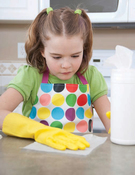Nonwoven fabrics are used in a number of wet wipe applications. The first use was in baby wipes; the fabric is saturated in a safe solution suitable for cleaning babies when the time comes to change their diapers. This cleaning aspect is now used in many applications, such as companion wipes to be used with toilet tissue, feminine hygiene wipes, make-up removal wipes, and many others.
Today, nonwoven wipes have evolved to the point where the nonwoven fabrics are used for delivering other cleaning liquids, too. There are tons of examples of these types of wipes. They are made to hold and deliver window cleaner, furniture cleaner, Armor-All treatment, antimicrobial agents—the list goes on and on.
Are You Aware Of What’s In Your Wet Wipe?
Currently almost all the nonwoven fabrics used in these applications are produced from man-made fibers; very few are made with any bleached cotton content at all. However, because these fabrics are generally white, soft, and absorbent—and since there is no requirement to label fiber content of the fabrics—most consumers believe that they are made from cotton.
Market research by Cotton Incorporated shows that 65% of consumers would like to see fiber content on the wipes package, and 62% reported that fiber content information would influence their purchase decision. 77% of consumers said cotton is their preferred fiber for wipes.
Head-To-Head, Which Fabric Wins?
General properties of cotton make it desirable for use as wet wipe fabric. Bleached cotton fabrics are soft, have high liquid retention, and become stronger when wet. To further quantify the benefits of cotton, Barnhardt produced hydroentangled fabrics made of 100% cotton, 100% Tencel™, 100% rayon, and 100% polyester. Also for comparison, a 100% air-laid pulp sample was included. Several tests related to wiping performance were conducted.
The 100% cotton wipe was found to have a higher coefficient of friction (ATSM test method D1894) on glass and simulated skin—keep in mind the higher the friction number, the better the material pick-up. Shuster Labs used a Gardner Apparatus, and the cleaning performance was measured. This test measured the removal of artificial fecal matter from simulated skin. Again, the 100% cotton fabric had better wiping performance, picking up the most fecal matter.
Beyond these more technical tests, AC Nielson also conducted a focus group to rate softness, and the 100% cotton fabric was rated softer than the other fabrics. This showcases that when it comes to cotton versus rayon—and other man-made fibers, for that matter—there really is no contest. The above properties and testing, along with this reminder that cotton is customer-preferred, is proof that bleached cotton is an excellent fiber for wet wipes.
To learn more about cotton than you could ever possibly want to know, please visit our Cotton Library.
